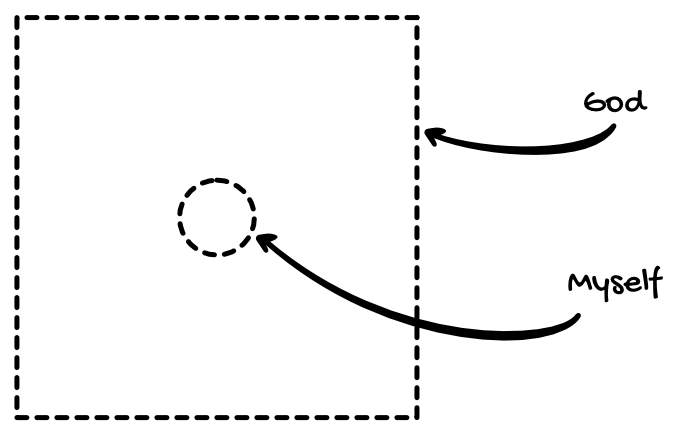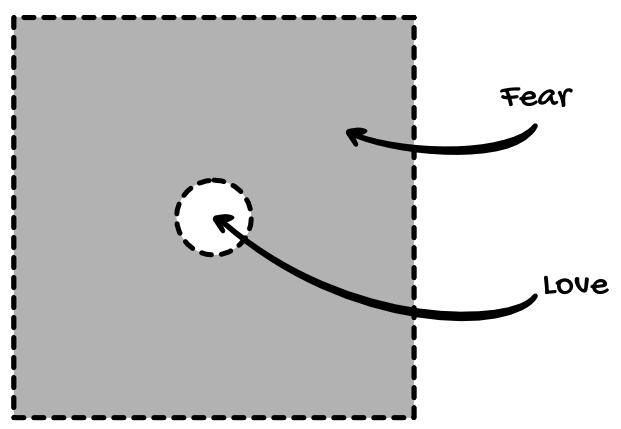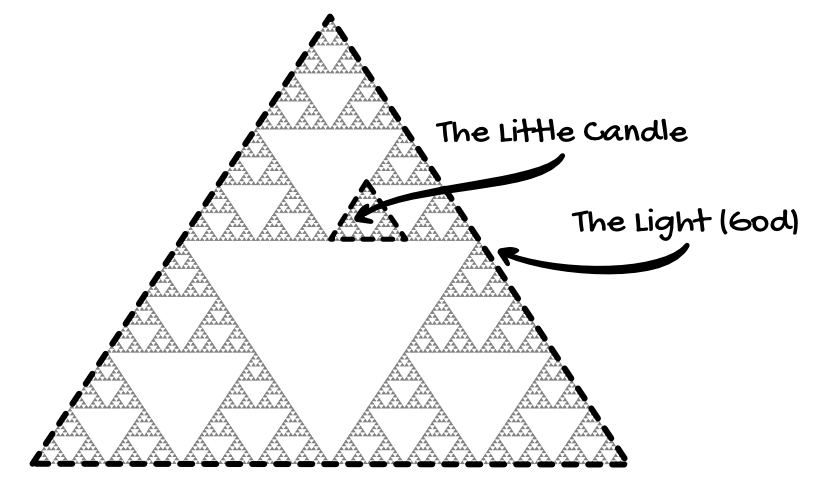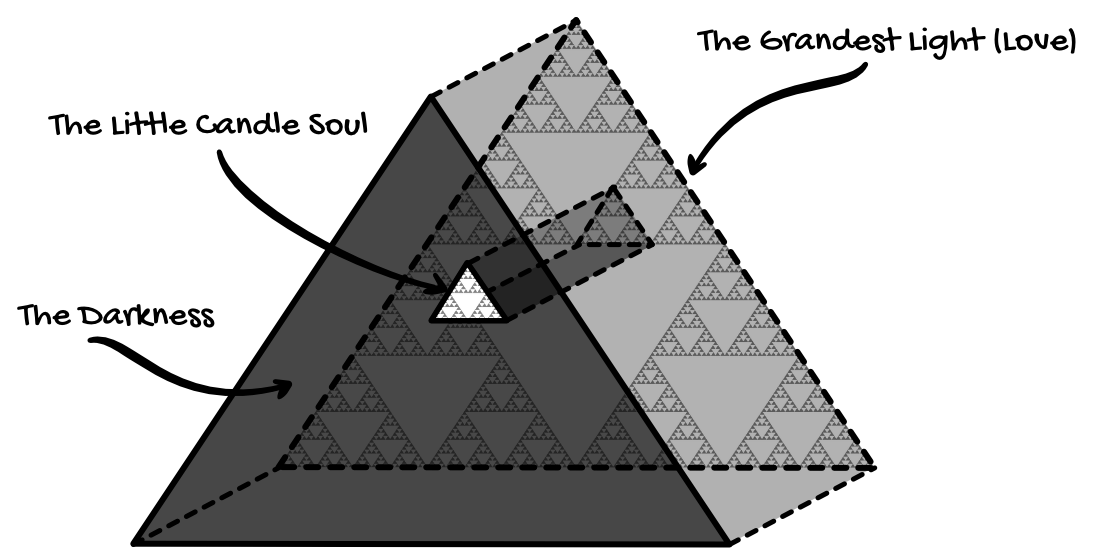"Anyway, now that we've had that little vulnerable interlude, let's return to this idea of love and fear. If I were to use the stencil analogy again, I could draw God's Markov blanket as enclosing the entire system. There is nothing God is not. If I were to draw my Markov blanket, however, it would be a tiny shape within the system. Who I Believe Myself To Be is so incredibly limited and small in comparison to God."

"Now," I said, "look at this puzzle. If God = love, and God = everything, then everything = love. So, what is fear?"
"Fear must be the area outside your Markov blanket," Zac replied.
"Exactly. Fear is any thought that would deny the Truth — and the Truth is, we're all God; we're all love; we're all everything; we're all One. Therefore, fear is a lie. If you treat it like a mathematical equation, love - fear = the observer. And the observer = Who I Believe Myself To Be. Therefore, love - fear = Who I Believe Myself To Be. Fear represents everything I believe myself not to be. The more fear I have, the more I have forgotten Who I Really Am — which is God; love; everything."

"Wait," Zac paused. "If fear is everything I am not, does that mean fear is everything I observe outside of myself? So, love = the observer and fear = the observed?"
"Conceptually, you can think about it that way — although it is a little esoteric. The word 'fear' in our language carries many connotations, so I don't want to confuse you with semantics. You just need to concern yourself with the overarching pattern that fear represents. I'll try to build a clearer model to explain what I mean. In Conversations With God, God says..."
In creating “something else” — namely, the realm of the relative — I have produced an environment in which you may choose to be God, rather than simply be told that you are God; in which you may experience Godhead as an act of creation, rather than a conceptualization; in which the little candle in the sun — the littlest soul — can know itself as the light.
Fear is the other end of love. It is the primal polarity. In creating the realm of the relative, I first created the opposite of My Self. Now, in the realm in which you live on the physical plane, there are only two places of being: fear and love.
Neale Donald Walsch
"Let's integrate this idea with the story of the little candle in the sun," I said.
There once was a soul who knew itself to be the light. This was a new soul, and so, anxious for experience. “I am the light,” it said. “I am the light.” Yet all the knowing of it and all the saying of it could not substitute for the experience of it. And in the realm from which this soul emerged, there was nothing but the light. Every soul was grand, every soul was magnificent, and every soul shone with the brilliance of My awesome light. And so the little soul in question was as a candle in the sun. In the midst of the grandest light — of which it was a part — it could not see itself, nor experience itself as Who and What it Really Is.
Neale Donald Walsch
"Here is a visual representation of the story so far," I said. "Let's treat 'light' as a metaphor for 'love.' The little soul is pure light (pure love) in an infinite ocean of the grandest light (the grandest love). This is the realm of the infinite; the implicate order; God. In this realm, there is nothing but love."

"As of now, the soul can know itself to be love in a purely conceptual way, but it can't experience itself as love. One cannot experience themselves as something unless the opposite also exists. For example, I cannot experience myself as tall unless short exists. Everything is defined relative to its opposite polarity. Let's keep reading."
Now it came to pass that this soul yearned and yearned to know itself. And so great was its yearning that I one day said, “Do you know, Little One, what you must do to satisfy this yearning of yours?”
“Oh, what, God? What? I’ll do anything!” The little soul said.
“You must separate yourself from the rest, of us,” I answered, “and then you must call upon yourself the darkness.’
“What is the darkness, o Holy One?” the little soul asked.
“That which you are not,” I replied, and the soul understood.
And so this the soul did, removing itself from the All, yea, going even unto another realm. And in this realm the soul had the power to call into its experience all sorts of darkness. And this it did.
Neale Donald Walsch
"If I illustrate this part of the story, you notice that The Darkness is just an illusive shadow cast over the top of The Light. The Light is still the fundamental Truth, but The Darkness allows the candle to experience itself as The Light. One can only experience themselves as The Light if The Darkness also exists."

"This parable is just another way of phrasing how God created the universe…"
And so All That Is divided Itself — becoming, in one glorious moment, that which is this, and that which is that. For the first time, this and that existed, quite apart from each other. And still, both existed simultaneously. As did all that was neither.
Thus, three elements suddenly existed: that which is here. That which is there. And that which is neither here nor there — but which must exist for here and there to exist.
It is the nothing which holds the everything. It is the non-space which holds the space. It is the all which holds the parts.
Neale Donald Walsch
"So," I continued, "we can conceptually model reality as a three-part structure. The explicate order consists of that which is here and that which is there. The implicate order is the nothing which holds the everything."

The observer and the observed make up the explicate order (i.e the illusory realm of the relative). The implicate order gives rise to the explicate order. "The implicate order is the realm of the infinite. It is the fundamental Truth. It is God. It is pure love. The implicate order also gives rise to the explicate order — the illusory realm of the relative that we experience.
The explicate order can be split into two parts: the observer and the observed. You'll notice that the observed is synonymous with fear because it represents everything that the little soul is not. The soul has forgotten that she is infinite because she is observing everything that she is not. You'll also notice, then, that fear is an illusion. It's not real. It's just a shadow obscuring the fundamental Truth: that the soul is God.
This triune pattern, consisting of that which is here (the observer), that which is there (the observed) and that which is neither here nor there — but which must exist for here and there to exist (the implicate order), is talked about here..."
Of course, you are well past the point where you must have it explained to you that the father-son descriptions of God have nothing to do with gender. I use here the picturesque speech of your most recent scriptures. Much earlier holy writings placed this metaphor in a mother-daughter context. Neither is correct. Your mind can best hold the relationship as: parent-offspring. Or: that-which-gives-rise-to, and that-which-is-risen. Adding the third part of the Trinity produces this relationship: That which gives rise to / That which is risen / That which is. This Triune Reality is God’s signature. It is the divine pattern. The three-in-one is everywhere found in the realms of the sublime. You cannot escape it in matters dealing with time and space, God and consciousness, or any of the subtle relationships. On the other hand, you will not find the Triune Truth in any of life’s gross relationships. [...]
Within the realm of gross relationships, nothing conceptualized can exist without a conceptualization of its opposite. Most of your day-to-day experience is foundationed in this reality.
Within the realm of sublime relationships, nothing which exists has an opposite. All Is One, and everything progresses from one to the other in a never-ending circle.
Time is such a sublime realm, in which what you call past, present, and future exist inter-relationally. That is, they are not opposites, but rather parts of the same whole; progressions of the same idea; cycles of the same energy; aspects of the same immutable Truth. If you conclude from this that past, present, and future exist at one and the same “time,” you are right. [...]
The world is the way it is because it could not be any other way and still exist in the gross realm of physicality. Earthquakes and hurricanes, floods and tornados, and events that you call natural disasters are but movements of the elements from one polarity to the other. The whole birth-death cycle is part of this movement. These are the rhythms of life, and everything in gross reality is subject to them, because life itself is a rhythm. It is a wave, a vibration, a pulsation at the very heart of the All That Is.
Neale Donald Walsch
"Now," I continued, "if we view our triune model from a birds-eye perspective, it transforms into the stencil analogy we have been using all along. Love is Who You Really Are, and fear is an illusory shadow that obscures your true self. Fear is literally forgetfulness."

I continued. "If I truly believed that I was God, I wouldn't have any fear. I wouldn't fear death because death is an illusion. I wouldn't fear poverty because I'm powerful enough to manifest as much abundance as I choose. I wouldn't fear criticism, because I'd know my inherent worthiness. The more fear I have, the more small and limited I remain."

